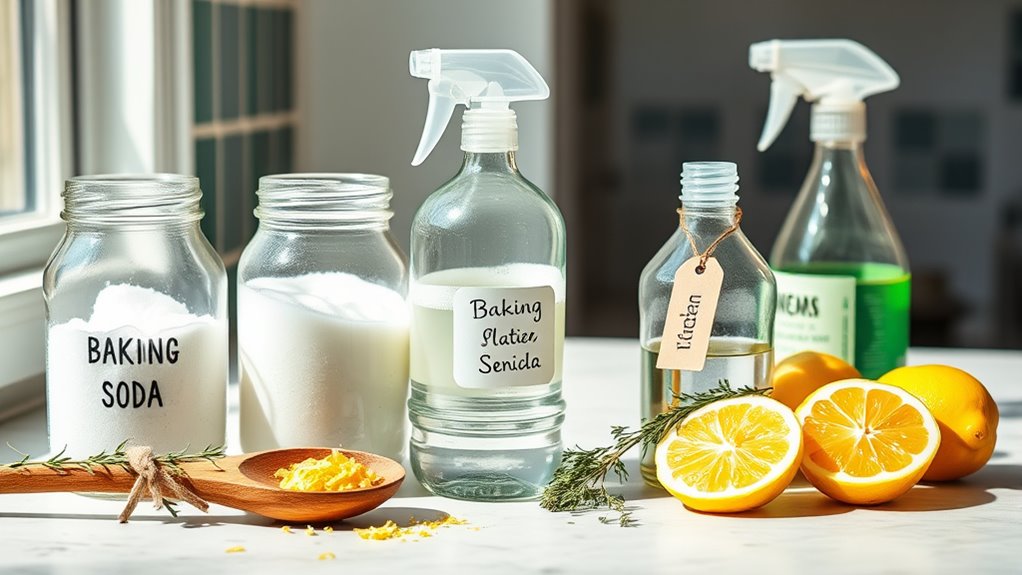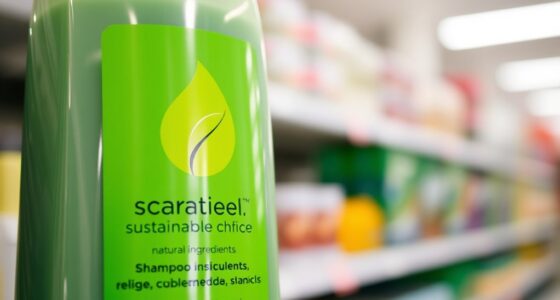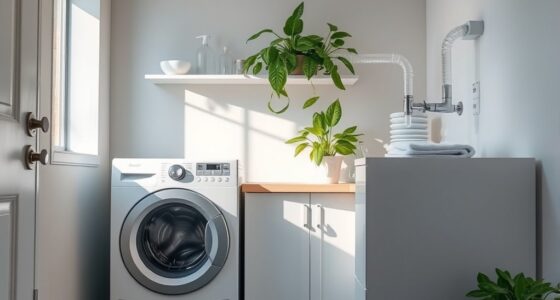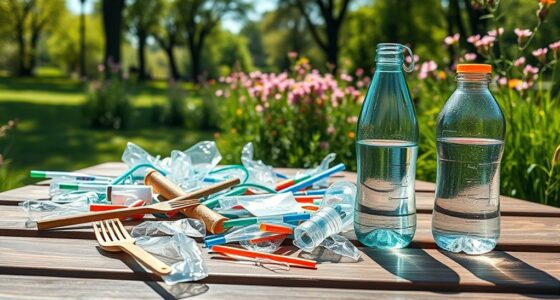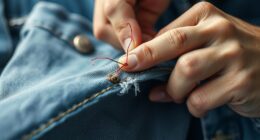In just five minutes, you can create eco-friendly cleaning essentials using simple ingredients and biodegradable tools. Mix equal parts water and white vinegar in a spray bottle, then add a few drops of tea tree or lemon oil for extra freshness and antimicrobial power. Keep a jar of baking soda handy for scrubbing sinks and tubs. Swap out plastic sponges for bamboo brushes or compostable cloths. Discover more quick swaps to make your home greener and safer.
Key Takeaways
- Create a DIY disinfectant by mixing equal parts white vinegar and water, adding essential oils for extra antimicrobial benefits.
- Use biodegradable plant-based scrub pads or bamboo brushes instead of plastic sponges for eco-friendly cleaning tools.
- Keep a jar of baking soda for quick scrubbing of sinks, tubs, and appliances to boost cleaning power naturally.
- Incorporate eco-friendly cleaning products made from natural ingredients that meet safety and sustainability standards.
- Make small, quick upgrades like replacing plastic tools with renewable resources to reduce your ecological footprint.

Switching to eco-friendly cleaning essentials not only helps protect the environment but also creates a healthier space for you and your family. You don’t need complicated or time-consuming methods to make a positive change—just a few simple ingredients and a bit of effort can make a big difference. One of the easiest ways to start is by whipping up your own DIY natural disinfectants. Instead of relying on harsh chemical cleaners, you can mix equal parts of white vinegar and water in a spray bottle. This solution effectively kills germs on countertops, bathroom fixtures, and other surfaces. For added freshness, toss in a few drops of your favorite essential oil, like tea tree or lemon, which also have natural antimicrobial properties. These DIY natural disinfectants are inexpensive, safe, and free from toxic fumes, making them perfect for households with kids or pets.
Another quick upgrade is switching to biodegradable cleaning tools. Traditional sponges and scrub brushes often contain synthetic materials that take years to decompose, contributing to landfill waste. Instead, choose biodegradable options like plant-based scrub pads, bamboo brushes, or compostable cloths. These tools work just as well as their plastic counterparts but break down naturally once they’ve reached the end of their lifespan. By replacing your standard cleaning tools with biodegradable ones, you reduce plastic waste and support sustainable practices. Plus, many biodegradable cleaning tools are durable and easy to clean, so they’ll serve you well for many uses.
Making your own natural cleaning solutions and swapping out plastic tools can be done in just five minutes, yet the impact is substantial. Keep a small jar of baking soda handy for scrubbing sinks, tubs, and appliances, and combine it with your DIY disinfectant sprays for versatile cleaning. These simple ingredients are not only effective but also gentle on your skin and the environment. Incorporating Vetted cleaning products into your routine can further enhance your eco-friendly efforts since they are made to meet high standards of safety and sustainability. When choosing cleaning tools, look for those made from bamboo, coconut fibers, or other renewable resources, which tend to be sturdy and eco-friendly. Incorporating these small changes into your routine is straightforward and empowering—you’ll feel good knowing you’re reducing your ecological footprint while maintaining a clean, safe home.
Frequently Asked Questions
Are Homemade Cleaning Solutions as Effective as Commercial Products?
You might wonder if homemade cleaning solutions are as effective as commercial products. Natural ingredients like vinegar and baking soda can tackle many common messes, but they often have a different chemical comparison to store-bought cleaners. While homemade solutions work well for everyday cleaning, they may lack the potency of commercial options for tough stains or disinfecting. Ultimately, your choice depends on your cleaning needs and preference for natural versus chemical-based products.
Can These Eco-Friendly Cleaners Be Safely Used Around Pets and Children?
You wonder if eco-friendly cleaners are safe around pets and children. The good news is, they often contain child-friendly ingredients and prioritize pet safety. When you choose or make these cleaners, look for natural, non-toxic ingredients like vinegar or baking soda. Always read labels, avoid harsh chemicals, and keep cleaners out of reach. This way, you protect your loved ones while keeping your home clean and eco-conscious.
How Long Do Homemade Cleaning Solutions Typically Last?
Homemade cleaning solutions usually last about a week to a month, depending on storage duration and ingredient stability. You should store them in airtight containers in a cool, dark place to maximize longevity. Natural ingredients like vinegar or lemon juice can degrade over time, reducing effectiveness. Always check for changes in smell or appearance before use, and make smaller batches if you want to guarantee freshness and safety.
Are There Any Common Allergens in DIY Cleaning Ingredients?
Ever wondered if DIY cleaning ingredients pose allergen exposure risks? You should know that common ingredients like vinegar, baking soda, and lemon are generally safe, but some people have ingredient sensitivities. Allergens can vary, so always test a small area first. To minimize risks, choose natural, hypoallergenic options and be aware of any personal allergen sensitivities. This way, you protect yourself while maintaining an eco-friendly cleaning routine.
What Storage Methods Ensure the Longevity of Homemade Cleaners?
To keep your homemade cleaners effective, store them properly in airtight containers to prevent contamination and evaporation. Place these containers in cool, dark places away from direct sunlight and heat sources, which can degrade their potency. Regularly check for any changes in smell or consistency, and label your containers clearly. Proper storage extends the shelf life of your DIY cleaners, ensuring they stay safe and effective for longer periods.
Conclusion
By making these eco-friendly cleaning essentials in just five minutes, you’re planting seeds of change in your home and the planet. Each natural ingredient becomes a gentle guardian, cleansing with the power of the earth itself. As you wipe away dirt, you’re also clearing a path toward a healthier world—one small act that blooms into a sustainable future. Embrace these simple recipes, and watch your effort grow into a garden of positive change.
